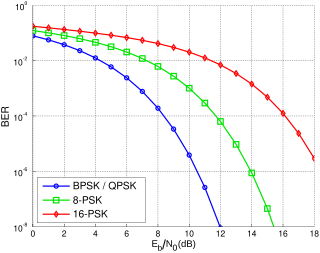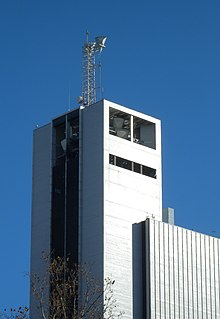The decibel is a relative unit of measurement corresponding to one tenth of a bel (B). It is used to express the ratio of one value of a power or root-power quantity to another, on a logarithmic scale. A logarithmic quantity in decibels is called a level. Two signals whose levels differ by one decibel have a power ratio of 101/10 or an amplitude ratio of 101⁄20.
In telecommunications, orthogonal frequency-division multiplexing (OFDM) is a type of digital transmission and a method of encoding digital data on multiple carrier frequencies. OFDM has developed into a popular scheme for wideband digital communication, used in applications such as digital television and audio broadcasting, DSL internet access, wireless networks, power line networks, and 4G/5G mobile communications.
Noise figure (NF) and noise factor (F) are measures of degradation of the signal-to-noise ratio (SNR), caused by components in a signal chain. It is a number by which the performance of an amplifier or a radio receiver can be specified, with lower values indicating better performance.
Signal-to-noise ratio is a measure used in science and engineering that compares the level of a desired signal to the level of background noise. SNR is defined as the ratio of signal power to the noise power, often expressed in decibels. A ratio higher than 1:1 indicates more signal than noise.
Diversity, diversify, or diverse may refer to:

In wireless communications, fading is variation of the attenuation of a signal with various variables. These variables include time, geographical position, and radio frequency. Fading is often modeled as a random process. A fading channel is a communication channel that experiences fading. In wireless systems, fading may either be due to multipath propagation, referred to as multipath-induced fading, weather, or shadowing from obstacles affecting the wave propagation, sometimes referred to as shadow fading.
Rician fading or Ricean fading is a stochastic model for radio propagation anomaly caused by partial cancellation of a radio signal by itself — the signal arrives at the receiver by several different paths, and at least one of the paths is changing. Rician fading occurs when one of the paths, typically a line of sight signal or some strong reflection signals, is much stronger than the others. In Rician fading, the amplitude gain is characterized by a Rician distribution.

In a spread-spectrum system, the process gain is the ratio of the spread bandwidth to the unspread bandwidth. It is usually expressed in decibels (dB).
The sensitivity of an electronic device, such as a communications system receiver, or detection device, such as a PIN diode, is the minimum magnitude of input signal required to produce a specified output signal having a specified signal-to-noise ratio, or other specified criteria.

In digital communication or data transmission, Eb/N0 is a normalized signal-to-noise ratio (SNR) measure, also known as the "SNR per bit". It is especially useful when comparing the bit error rate (BER) performance of different digital modulation schemes without taking bandwidth into account.
Space–time block coding is a technique used in wireless communications to transmit multiple copies of a data stream across a number of antennas and to exploit the various received versions of the data to improve the reliability of data transfer. The fact that the transmitted signal must traverse a potentially difficult environment with scattering, reflection, refraction and so on and may then be further corrupted by thermal noise in the receiver means that some of the received copies of the data may be closer to the original signal than others. This redundancy results in a higher chance of being able to use one or more of the received copies to correctly decode the received signal. In fact, space–time coding combines all the copies of the received signal in an optimal way to extract as much information from each of them as possible.

Antenna diversity, also known as space diversity or spatial diversity, is any one of several wireless diversity schemes that uses two or more antennas to improve the quality and reliability of a wireless link. Often, especially in urban and indoor environments, there is no clear line-of-sight (LOS) between transmitter and receiver. Instead the signal is reflected along multiple paths before finally being received. Each of these bounces can introduce phase shifts, time delays, attenuations, and distortions that can destructively interfere with one another at the aperture of the receiving antenna.
Diversity combining is the technique applied to combine the multiple received signals of a diversity reception device into a single improved signal.
In telecommunications, the carrier-to-noise ratio, often written CNR or C/N, is the signal-to-noise ratio (SNR) of a modulated signal. The term is used to distinguish the CNR of the radio frequency passband signal from the SNR of an analog base band message signal after demodulation, for example an audio frequency analog message signal. If this distinction is not necessary, the term SNR is often used instead of CNR, with the same definition.
In the field of wireless communication, macrodiversity is a kind of space diversity scheme using several receiver antennas and/or transmitter antennas for transferring the same signal. The distance between the transmitters is much longer than the wavelength, as opposed to microdiversity where the distance is in the order of or shorter than the wavelength.
In telecommunications, a diversity scheme refers to a method for improving the reliability of a message signal by using two or more communication channels with different characteristics. Diversity is mainly used in radio communication and is a common technique for combatting fading and co-channel interference and avoiding error bursts. It is based on the fact that individual channels experience different levels of fading and interference. Multiple versions of the same signal may be transmitted and/or received and combined in the receiver. Alternatively, a redundant forward error correction code may be added and different parts of the message transmitted over different channels. Diversity techniques may exploit the multipath propagation, resulting in a diversity gain, often measured in decibels.

In communication systems, array gain means a power gain of transmitted or received signals that is achieved by using multiple antennas or antenna elements at a transmitter or receiver, with respect to a single antenna or antenna element case. It can be simply called power gain. In a broadside array, the array gain is almost exactly proportional to the length of the array. This is the case provided that the elements of the antenna are not spaced to a point at which large radiation side lobes form in other directions and that the array length exceeds one or two wavelengths. The power gain of a broadside array is nearly independent of the number of broadside elements as long as both of these conditions are met.
Precoding is a generalization of beamforming to support multi-stream transmission in multi-antenna wireless communications. In conventional single-stream beamforming, the same signal is emitted from each of the transmit antennas with appropriate weighting such that the signal power is maximized at the receiver output. When the receiver has multiple antennas, single-stream beamforming cannot simultaneously maximize the signal level at all of the receive antennas. In order to maximize the throughput in multiple receive antenna systems, multi-stream transmission is generally required.
Cooperative diversity is a cooperative multiple antenna technique for improving or maximising total network channel capacities for any given set of bandwidths which exploits user diversity by decoding the combined signal of the relayed signal and the direct signal in wireless multihop networks. A conventional single hop system uses direct transmission where a receiver decodes the information only based on the direct signal while regarding the relayed signal as interference, whereas the cooperative diversity considers the other signal as contribution. That is, cooperative diversity decodes the information from the combination of two signals. Hence, it can be seen that cooperative diversity is an antenna diversity that uses distributed antennas belonging to each node in a wireless network. Note that user cooperation is another definition of cooperative diversity. User cooperation considers an additional fact that each user relays the other user's signal while cooperative diversity can be also achieved by multi-hop relay networking systems.

In radio, multiple-input and multiple-output, or MIMO, is a method for multiplying the capacity of a radio link using multiple transmission and receiving antennas to exploit multipath propagation. MIMO has become an essential element of wireless communication standards including IEEE 802.11n (Wi-Fi), IEEE 802.11ac (Wi-Fi), HSPA+ (3G), WiMAX, and Long Term Evolution. More recently, MIMO has been applied to power-line communication for 3-wire installations as part of ITU G.hn standard and HomePlug AV2 specification.






